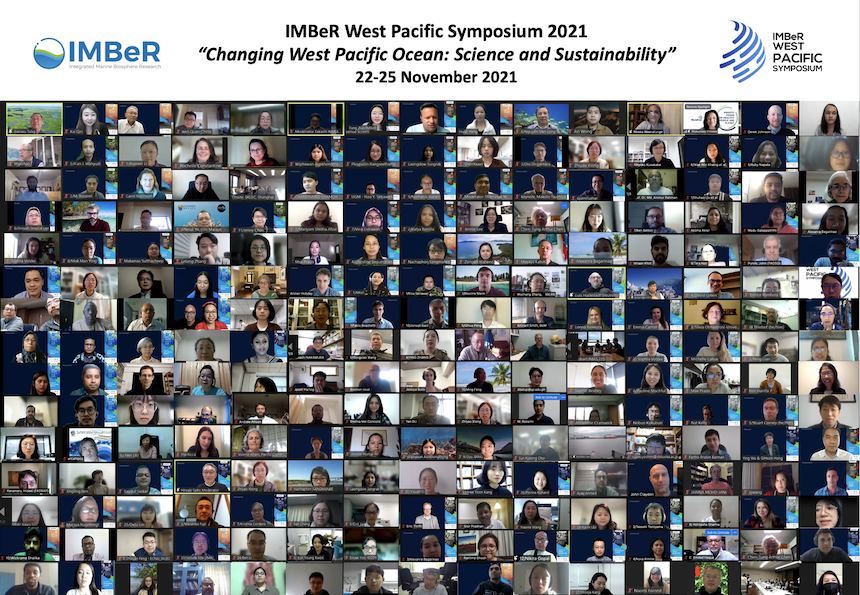“变化中的西太平洋:科学与可持续”— 国际海洋生物圈整合研究计划(IMBeR)西太平洋会议在线召开
The International Project Office-China of the IMBeR and the State Key Laboratory of Estuarine and Coastal Research at East China Normal University held an international symposium on the Changing Marine Biosphere in the West Pacific Ocean: Science and Sustainability during November 22-25 in Shanghai. This online event drew more than 900 participants and more than 160 presentations to provide new scientific observation results and perspectives on the changing marine biosphere in the West Pacific Ocean and its neighboring Indian and Southern oceans. It brought many notable success stories about how scientific research activities empower us to cope with changing oceans due to global warming and harness the ocean’s wealth sustainably. This symposium was also supported by the United Nations Decade of Ocean Science for Sustainable Development (2021-2030).
国际海洋生物圈整合研究计划(IMBeR)西太平洋会议于2021年11月22日至25日在线举办,会议主题是:变化中的西太平洋—科学与可持续。会议得到了联合国“海洋科学促进可持续发展十年(2021-2030)”行动的支持。依托华东师范大学河口海岸学国家重点实验室设立的IMBeR国际项目办公室(中国)作为本次大会的秘书处,负责组织协调工作。
会议吸引了全球900余名专家学者和各界人士参加,学术报告共计160余场。专家学者们围绕西太平洋及其邻近的印度洋和南大洋不断变化的海洋生物圈,呈现并交流了新的科学观测结果和学术观点。很多科技赋能、全球变暖引发的海洋问题应对,以及海洋资源可持续利用等成功案例在会上得以分享。
Oceans and lands have migrated their position continuously since the formation of the Earth. So the climate has changed accordingly with occasional mass extinction. Currently, the Pacific/Philippine plates underneath the West Pacific Ocean collides with the northward moving Australia Plate at a speed of 7-11 centimeters a year. The colliding of those plate boundaries generates the most catastrophic earthquakes and volcanic eruptions on Earth to trigger tsunamis and emitted massive volcanic gases and ashes into the sea such as Banda Ache in 2004, off Fukushima in 2011, Mayon in 2008 and many other active volcanoes in the West Pacific.
The northward movement of India plate collided with the Eurasian plate to form the Tibetan Plateau about fifty million years ago. More than 8 km high plateau blocks the circumnavigational trade winds that result in the Asian Monsoon climate.
The close-in northward movement of the Australian continent has formed the current Indonesian Australian Archipelago, which has brought the survived fauna of the ancient Tethys Sea. It contributes to a biodiversity hotspot in the marine biosphere. And the shallow central Indo-Pacific region blocks circumnavigational ocean water flow, thus forming the warm pool in the West Pacific.
More than half of the global population have chosen the coastal regions along the West Pacific and the Indian Ocean as their habitats. They are dependent on the oceans for their livelihoods by and large.
Therefore, we may characterize the West Pacific as the global center of heat, water, tectonic energy, and population, especially the central Indo-Pacific region.
自地球形成以来,海洋和陆地的分布格局一直处于不断变化中。因此,气候也不断发生相应的变化,偶尔会发生物种大规模灭绝。目前,澳大利亚板块正以每年7-11厘米的速度向北移动,与位于西太平洋的太平洋/菲律宾板块相互挤压。这些板块边界的相互挤压、碰撞或俯冲引发了地球上最具灾难性的地震和火山爆发,进而引发海啸和喷发出大量的火山气体、火山灰进入海洋,例如2004年在班达亚齐的海啸、2011年在福岛附近海域的地震、以及2018年马荣火山的喷发等。大约五千万年前,印度板块北移与欧亚板块相碰撞,形成了青藏高原,超过 8 千米海拔的高峰阻挡了信风,导致了亚洲季风气候。澳大利亚大陆的北移形成了现在的马来群岛,保留下了古特提斯海的遗存动物群,并造就了这一海洋生物圈的生物多样性热点地区。而印度洋-太平洋中部浅海区阻碍了海洋环流,从而形成了西太平洋暖池。全球超过一半的人口居住在西太平洋和印度洋沿岸地区,总的来说,他们的生计依赖于海洋。因此,我们或许可将西太平洋描述为全球热量、水汽、地质动力和人口的中心,特别是印度洋-太平洋中部地区。
Systematic and comprehensive scientific research initiatives in the Indo-Pacific region have recently addressed many facets of the natural processes. Prof. Fan Wang (Institute of Oceanology, Chinese Academy of Sciences) introduced an overview of the Chinese research plan on plate convergence, the formation of biodiversity, and the intertropical convergence zone (ITCZ). Other Chinese scientists presented the effects of variation of ITCZ on the regional seawater flows and marine biodiversity. Scientists from Indonesia, Malaysia, and the Philippines also delivered their research outcomes. Their scientific findings and plans were well received.
最近在印度洋-太平洋地区开展的系统性、综合性的科学研究计划大多涉及自然过程的许多方面。中国科学院海洋研究所所长王凡研究员介绍了中国在板块汇聚、生物多样性形成和热带辐合带(Intertropical Convergence Zone, ITCZ)等方面研究计划的概况。其他中国科学家介绍了ITCZ的变化对区域海流和海洋生物多样性的影响。来自印度尼西亚、马来西亚和菲律宾的科学家也展示了他们的研究成果。这些科学发现和科学计划受到与会人士的广泛关注。
The regional populations have thrived their civilization by utilizing oceans’ contribution to their needs and have tried to adapt to such natural changes. The recent human-induced climate and environmental changes brought many additional challenges.
Policy objectives to meet the marine ecosystem protection, seafood production, and protecting other legitimate uses of the same sea space are shared challenges of all regional societies. They are seemingly complex and often contradictory. Scientists in the region have attempted to meet such societal demands. One of the fine examples presented in the symposium was on Sanggou Bay, China. A group of dedicated scientists led by Hui Liu (Yellow Sea Fisheries Research Institute, Chinese Academy of Fishery Sciences) developed and operationalized various scientific decision support tools for marine functional zoning administration of the bay. The high resolution (10 m – 1 km) hydrodynamic model, water quality model, ecosystem coupled individual aquaculture species (kelp, yesso scallop, Pacific oyster, and abalone) growth models are notable ones. Harmonizing those ecosystem models, they were able to develop an Aquaculture Planning Decision Support System (APDSS) to evaluate their site suitability.
The Sanggou Bay approach and programs should benefit a world community to enhance the oceans’ contribution to the people without sacrificing the natural ecosystem and service.
在该区域,人类通过利用海洋对其需求的贡献来繁荣其文明,并努力适应这种自然变化。近期人类活动引起的气候和环境变化带来了许多额外的挑战。
实现海洋生态系统保护、满足水产品供给、保障同一海域其他合法用海活动等是各地区社会面临的共同挑战。这些政策目标不仅看似复杂,而且往往相互冲突。该地区的科学家已经在致力于解决这些社会需求,在中国桑沟湾开展的工作就是本次会议上展示的优秀案例之一。由中国水产科学研究院黄海水产研究所刘慧研究员领衔的科学家团队为桑沟湾海洋功能区划管理提供了丰富的科学决策工具,其中值得关注的有高分辨率水动力(10米至1公里)模型、水质模型和生态系统耦合养殖物种生长模型。在整合这些生态系统模型的基础上,该团队研发了水产养殖空间规划决策支持系统(Aquaculture Planning Decision Support System, APDSS),以评估养殖区选址的适宜性。在桑沟湾开展的项目与工作有助于国际社会在不牺牲自然生态系统与其服务功能的情况下,增强海洋对人类的贡献。
The symposium also covered coastal blue carbon, coral reefs, dried small fish, marine-extreme events, oceanic top predators, and the tropical ocean ecosystem. It forged a camaraderie among the scientists and stakeholders interested in the West Pacific and its neighboring oceans from more than 70 countries. It will serve as a forum to develop new forms of collaboration in the years to come amid the current unprecedented COVID-19 pandemic.
本次会议还涉及了海岸带蓝碳、珊瑚礁、小鱼干、海洋极端事件、海洋顶级捕食者、热带海洋生态系统等研究内容,为来自70多个国家关注西太平洋及其邻近海域的科学家及各利益相关方搭建了友好的交流平台。会议将以此为基础,服务、发展适合后疫情时代的新型合作伙伴关系。

